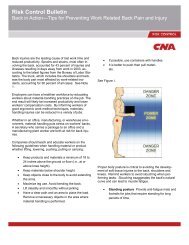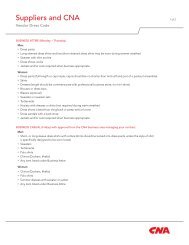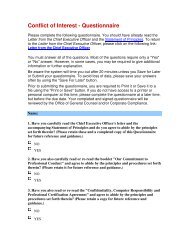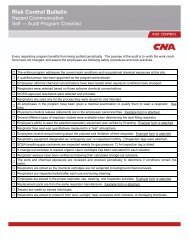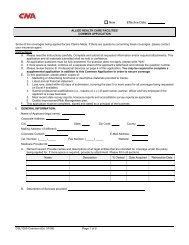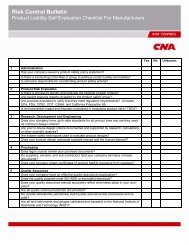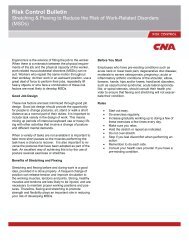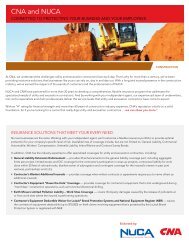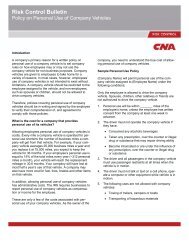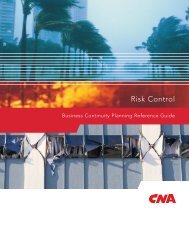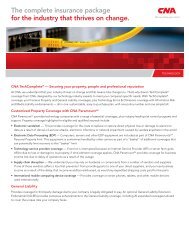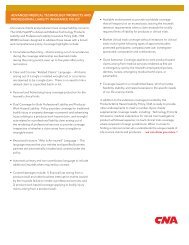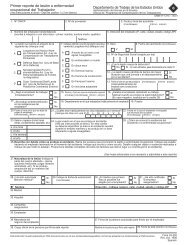Chemicals-Control of Carbon Monoxide Gas - CNA
Chemicals-Control of Carbon Monoxide Gas - CNA
Chemicals-Control of Carbon Monoxide Gas - CNA
You also want an ePaper? Increase the reach of your titles
YUMPU automatically turns print PDFs into web optimized ePapers that Google loves.
Risk <strong>Control</strong> Bulletin<strong>Chemicals</strong>—<strong>Control</strong> <strong>of</strong> <strong>Carbon</strong> <strong>Monoxide</strong> <strong>Gas</strong>Reduction <strong>of</strong> Lift Trucks Emissions<strong>Carbon</strong> monoxide (CO) is odorless, tasteless, colorless,non-irritating and cannot be detected by any <strong>of</strong> thesenses. Because it cannot be detected, employees canbe exposed to very high levels without realizing there is aproblem. CO can accumulate rapidly in the environment.How much CO gas is emitted and how quickly it concentratesin a building depends on:The number <strong>of</strong> forklifts idling or operatingHow well the engines are tunedLength <strong>of</strong> time the forklifts operateHow fast fresh air and ventilation dilute the COReducing vehicle CO gas emissions is the most effectiveway to lower the workers’ occupational exposures. Relyingupon a ro<strong>of</strong> fan in the building to exhaust the CO gasto acceptable health limits provides a false sense <strong>of</strong> security.Because engine exhaust is hot, the exhaust gas initiallyrises quickly towards the ro<strong>of</strong> <strong>of</strong> the building. However,the exhaust fan cannot effectively control the COconcentration due to poor ventilation design, confinedspaces, and the large emission volume. There are commercialproducts and effective engineering control methodsthat should help keep the lift truck’s CO gas emissionsat their lowest potential level.Emission <strong>Control</strong> ChecklistMinimizing vehicle emissions is the most effective preventivestep. These exposure-reducing options should helplower the lift truck’s CO gas emissions.1. Instruct drivers to turn <strong>of</strong>f the lift truck enginewhen it is not being used.This is a cost-effective control. However, driversmay need to be reminded during the coolermonths when the buildings are closed up for energyconservation. Less fresh outdoor air will enterthe building to dilute and dissipate the CO gasemissions.2. Use a precision tune-up service.The mechanic needs to use a direct-reading COgasmeter. The meter’s probe needs to be placedin the truck’s tail pipe. This measurement allowsthe mechanic to adjust the air-fuel mixture to setthe engine at its most efficient level. Lift truckscan emit from three to eight percent CO gas if out<strong>of</strong> tune. That might seem low but a 1% emissionrate produces 10,000 ppm <strong>of</strong> CO gas. The federalOSHA personal exposure limit is set at 50 ppm.3. Use a propane-fuel detergent to help keep theengine’s fuel jets clean.The detergent needs to be added by the LPGsupplier.4. Install a catalytic converter on the truck’s exhaustpipe.The converter regulates the fuel flow to the engine’scarburetor by sensing the hydrocarbon’semission gases in the tailpipe. This converter oxidizesthe gas emissions into harmless water vaporand carbon dioxide gas.5. Install an electronic fuel regulator.An oxygen sensor is inserted in the exhaust pipethat measures the fuel to air mixture ratio. Thecontrol valve allows the proper amount <strong>of</strong> air toenter the carburetor. Some products are aclosed-loop combination <strong>of</strong> a fuel regulator and acatalytic converter in the muffler. Different convertersare more effective for the different types<strong>of</strong> fuel, such as LPG or CNG. An <strong>of</strong>fensive ammonia-likeodor can be generated when thewrong converter has been installed.You may need to use two or more engineering controls incombination to obtain the desired CO gas reduction.As a last step, switch to battery powered trucks when theCO gas level cannot be effectively lowered by the otherengineering controls. This step may be more cost effectivein lowering the employees’ CO gas exposures beforeaddressing building ventilation. Exhaust ventilation for thebuilding is an excellent engineering control. However, it is
2Titlecostly to temper (heat/ cool) the large volume <strong>of</strong> outdoormake-up air, which needs to be brought into the building.The building may require increased or improved ventilation.Refer to the article entitled, “<strong>Chemicals</strong> - <strong>Carbon</strong><strong>Monoxide</strong> Emission Calculation Based on Building Size,”for additional information on how to estimate the volume<strong>of</strong> air needed for dilution.Good driving techniques can also help reduce CO emissions,such as jerky operations and racing the engine, willrelease more carbon monoxide gas. Employees shouldbe provided health hazard training and exposure symptominformation. The checklist attached at the end <strong>of</strong> thisdocument was provided for a guideline.These are some factors associated with CO poisoningcaused by LPG forklifts‣Used fuel driven forklifts indoors.‣Used fuel driven forklifts in or near cold storagerooms (rooms or semi-trailers with little or no ventilation).‣Renting a forklift for the first time or renting from adifferent vendor.‣Failure to verify emission tests <strong>of</strong> rental lifts.‣Building ventilation was not working properly.‣Routing forklift traffic through populated work areas.‣Employees who worked near a forklift or dieseltruck while the truck idled its engine.Testing the vehicle’s exhaust is the best way to know theCO gas emission. The emissions from the exhaust pipewould be both hot and at a very high concentration; therefore,a special setup is required. The exhausted gasesneed to be cooled and the meter needs to read out highconcentrations. Meters like that can be rented. Also, calibratethe test meter prior to testing to be sure it is operatingproperly.Electric forklifts do not produce CO gas and may be themost reliable solution to eliminate CO poisoning in yourworkplace. Electric forklifts are the only type <strong>of</strong> lift thatshould be used in spaces that are indoor, small and enclosed,and/or have no ventilation. Examples where electriclifts are most appropriate include the following situations: All indoor spaces Enclosed spaces with little or no ventilation Refrigerated storage warehousesEconomicsCold rooms<strong>Control</strong>led atmosphere roomsCargo containers and semi-trailersThe theoretical ratio at which all propane fuel will beburned using all <strong>of</strong> the oxygen in the air is 15.2 pounds <strong>of</strong>air burned for every 1 pound <strong>of</strong> fuel. <strong>Gas</strong>oline engine air/fuel ratio is 14.7:1.Rich mixtures not only burn more fuel than necessary, butthey generate high levels <strong>of</strong> CO as waste gas. In “lean”air/fuel ratios (ratios > 15.2:1), excess air is present duringcombustion, leading to elevated production <strong>of</strong> nitrogenoxides (NOx), another toxic gas pollutant. The optimal air/fuel mixture for propane engines is a ratio <strong>of</strong> 15.2:1. Enginestuned to this ratio get the best fuel economy andemit low CO emissions at approximately 0.5%.A forklift that emits 5% CO gas will waste approximately375 more gallons <strong>of</strong> propane per year per shift comparedto a lift that emits only 0.5% CO gas. At propane fuelprices <strong>of</strong> $1 to $2 per gallon, lifts emitting 5% CO maywaste $375 to $750 per year on a single 8-hour shift.Building Ventilation SuggestionsEngine exhaust is hot so the emission gases rise quicklytowards the ro<strong>of</strong> <strong>of</strong> the building. Many single story buildingshave installed ro<strong>of</strong> mounted exhaust fans to removehot air and gases. However, ro<strong>of</strong> fans can only exhaustthe hot gases that are near those ceiling fans. CO gashas about the same density as air. The CO gas will driftdown from the ceiling as the hot exhaust gases cool andmix into the air. Exhaust gases cool down even morequickly in the wintertime so the CO gas concentration insidethe building increases. If the building has paddle fansto push the warm air down towards the employees, thenits air movement created by those fans that are used canquickly disburse the CO gas throughout the building.A good ventilation system needs to replace the sameamount <strong>of</strong> exhausted air that leaves the building. If thebuilding is closed tight in the wintertime, then not enoughmake-up air will be provided. A negative pressure will becreated in the building. Exterior doors will feel harder toopen. The exhaust ventilation system's efficiency wouldbe adversely affected after a negative pressure has developed.You may see the fan blades moving or hear the2
3Titlefan motor but the ventilation system is not operating effectively.A false impression that the system is operating correctlymay occur.Fresh outdoor air is normally brought into the building atthe ro<strong>of</strong> or gable peak. The fresh make-up air should bebrought into the building as far away as possible from theexhaust fan for the best results. For example, the fresh airshould be brought into the building from the north end andexhaust from the south end <strong>of</strong> the building. If the make-upair is brought into the building too close to the exhaust,then a condition called "short-circuiting" might occur.What happens is the exhaust fan could quickly draw insome <strong>of</strong> the fresh air and exhaust it out <strong>of</strong> the buildingbefore that fresh air was allowed to diffuse properly.Figure-1 illustrates the supply and exhaust fan placementin a building. The supplied air was directed down towardsthe floor in this example.The blower fan is usually attached on a floor-mountedmetal post that swings or pivots. The post can be swungso the fan is quickly positioned at the top and side <strong>of</strong> theopen semi-trailer. The fan should be positioned so the lifttruck’s rollbar will not hit it when the truck is driving in andout <strong>of</strong> the trailer. Those fans operate similar to a spotlightthat is used for supplemental lighting. Often the fan iscoupled with a high beam supplemental lamp so thetrailer can be ventilated and lighted at the same time. Figure-2illustrates the placement <strong>of</strong> an axial fan, whichblows air into the trailer to dissipate the CO gas.Figure-1Specific areas in the building may have high CO gas concentrations,such as the loading dock. You want the maximumamount <strong>of</strong> the building’s air to be exhausted nearthe loading dock area. Locating an exhaust fan in thedock area would provide effective capture, and the highestamount <strong>of</strong> CO gas in the building should be exhausted.Figure-2A pedestal-cooling fan also works; but requires theworker’s cooperation to be effective. The pedestal fanwould need to be manually positioned correctly at the entrance<strong>of</strong> the trailer. Another type <strong>of</strong> fan is called an axialfan, which is a small diameter size so it can be positionedat the top corner <strong>of</strong> the trailer opening so not to impedethe lift truck entering the trailer. Blowing air into a trailer tolower the CO level is about 100 times more effective thansucking the air out.Supplemental Semi-Trailer VentilationActivities may require a lift truck to operate inside a small,enclosed area, such as semi-trailers. The CO gas concentrationinside a trailer can quickly elevate. There is noplace for the trucks' exhaust gases to escape from thatconfined space. However, there are specialized axial fansthat are designed to blow the building air inside the trailerto dilute the CO gas concentration. This is a smalldiameterfan, which is shaped like a bullet.3
4TitleEmployee Training Checklist for <strong>Carbon</strong> <strong>Monoxide</strong> (CO)The checklist can serve as a guide for topics that should be covered in employee trainingDateDiscussedTopicDiscuss where carbon monoxide gas is generated at your company<strong>Carbon</strong> monoxide gas cannot be detected by your senses.You cannot taste itYou cannot see itYou cannot smell it, but a person might smell the other engine gas emissions in the airSigns and symptoms <strong>of</strong> CO poisoning:Feels like sudden onset <strong>of</strong> the fluRapid breathingHeadacheChest painDizzinessUnconsciousnessNauseaDeath (see Chart-1)How drivers can protect themselves and others:Do not allow lifts to idle when not in use.Keep engines well tuned to emit 1% CO or less.Do not adjust the carburetor outside <strong>of</strong> a tune-up.Maintain catalytic converters.Do not operate fuel-driven lifts in non-ventilated areas.Immediately remove lifts suspected <strong>of</strong> high CO from operation.Be wary <strong>of</strong> rental lifts. Ask the vendor what percentage <strong>of</strong> CO they emit.How employees can protect themselves and others:Seek help immediately if you suspect CO poisoning.Do not work in confined areas with fuel-driven lifts.Report non-working ventilation immediately to supervisor.Notify supervisor immediately if CO alarm sounds.Watch for illness in your co-workers.Pay attention to unusual situations that have caused CO poisoning in the past:Restricted ventilation for any reason.Non-functional ventilation.Use <strong>of</strong> rented forklifts without knowledge <strong>of</strong> CO emissions.Re-routed forklift traffic closer to worker stations.CO monitoring in the workplace:What the CO monitors do.What the alarms mean.Action to take when an alarm sounds.Emergency response:Seek fresh air immediately if you suspect CO poisoning.Call 911 for victims who are ill or unconscious.4
5Title(ppm) parts <strong>of</strong> CO gas per million <strong>of</strong> air <strong>of</strong> contaminated air by volume.(*) Sources:U.S. Department <strong>of</strong> Labor, Occupational Safety & Health Administration, <strong>Carbon</strong> <strong>Monoxide</strong> (by COHb),http://www.osha.gov/dts/chemicalsampling/data/CH_225610.htmlU.S. Department <strong>of</strong> Labor, Occupational Safety & Health Administration, <strong>Carbon</strong> <strong>Monoxide</strong>,http://www.osha.gov/SLTC/healthguidelines/carbonmonoxide/index.html, andhttp://www.osha.gov/SLTC/healthguidelines/carbonmonoxide/recognition.html#medicalsurveillanceDHHS (NIOSH) Publication No. 79-122, “Adverse Health Effects <strong>of</strong> Smoking and the Occupational Environment,” February5, 1979, http://www.cdc.gov/niosh/73-11000.htmlU.S. Department <strong>of</strong> Labor, Occupational Safety & Health Administration, “Occupational Health Guideline for <strong>Carbon</strong><strong>Monoxide</strong>,” September 1978(**) American Conference <strong>of</strong> Governmental Industrial Hygienists, 1330 Kemper Meadow Drive, Cincinnati, Ohio 45240,“Industrial Ventilation: A Manual <strong>of</strong> Recommended Practice”(***) In 1972, the National Institute for Occupational Safety and Health (NIOSH) published a criteria document. Thedocument recommended that occupational exposures to CO be maintained to a level that will not induce an increasein COHb level greater than five percent. NIOSH established a recommended exposure limit (REL) for CO at 35 ppm asa TWA for up to an eight-hour workday. A ceiling limit concentration was set at 200 ppm, which should not be exceededat anytime during the work shiftReferenceThe effect <strong>of</strong> a gas inhaled increases with depth. The effect <strong>of</strong> 25 ppm at a depth <strong>of</strong> 50 meters would be comparable tothat <strong>of</strong> 150 ppm <strong>of</strong> CO breathed at sea level.The information, examples and suggestions presented in this material have been developed from sources believed to be reliable, but they should not be construed as legal or other pr<strong>of</strong>essional advice.<strong>CNA</strong> accepts no responsibility for the accuracy or completeness <strong>of</strong> this material and recommends the consultation with competent legal counsel and/or other pr<strong>of</strong>essional advisors before applying thismaterial in any particular factual situations. This material is for illustrative purposes and is not intended to constitute a contract. Please remember that only the relevant insurance policy can provide theactual terms, coverages, amounts, conditions and exclusions for an insured. All products and services may not be available in all states and may be subject to change without notice. <strong>CNA</strong> is a registeredtrademark <strong>of</strong> <strong>CNA</strong> Financial Corporation. Copyright © 2010 <strong>CNA</strong>. All rights reserved.5



